CTEC0701: System Analysis & Design Portfolio - Empire Theatre
VerifiedAdded on 2022/08/26
|13
|1296
|22
Project
AI Summary
This assignment is a system analysis and design portfolio for the Empire Theatre, developed as part of the CTEC0701 Problem Solving & Programming module. The project encompasses several key aspects of system development, including a Gantt chart for project management, detailed system requirements analysis (identifying actors, functional and non-functional requirements, and MoSCoW prioritization), use case diagrams with descriptions, and class diagrams. Furthermore, the portfolio suggests additional functionalities such as ticket cancellation/refunds, profile updates, and contact support to enhance the system. The analysis is supported by relevant literature and aims to provide a comprehensive overview of the system's design and functionality. The assignment demonstrates a strong understanding of system analysis and design principles, including UML modeling techniques.
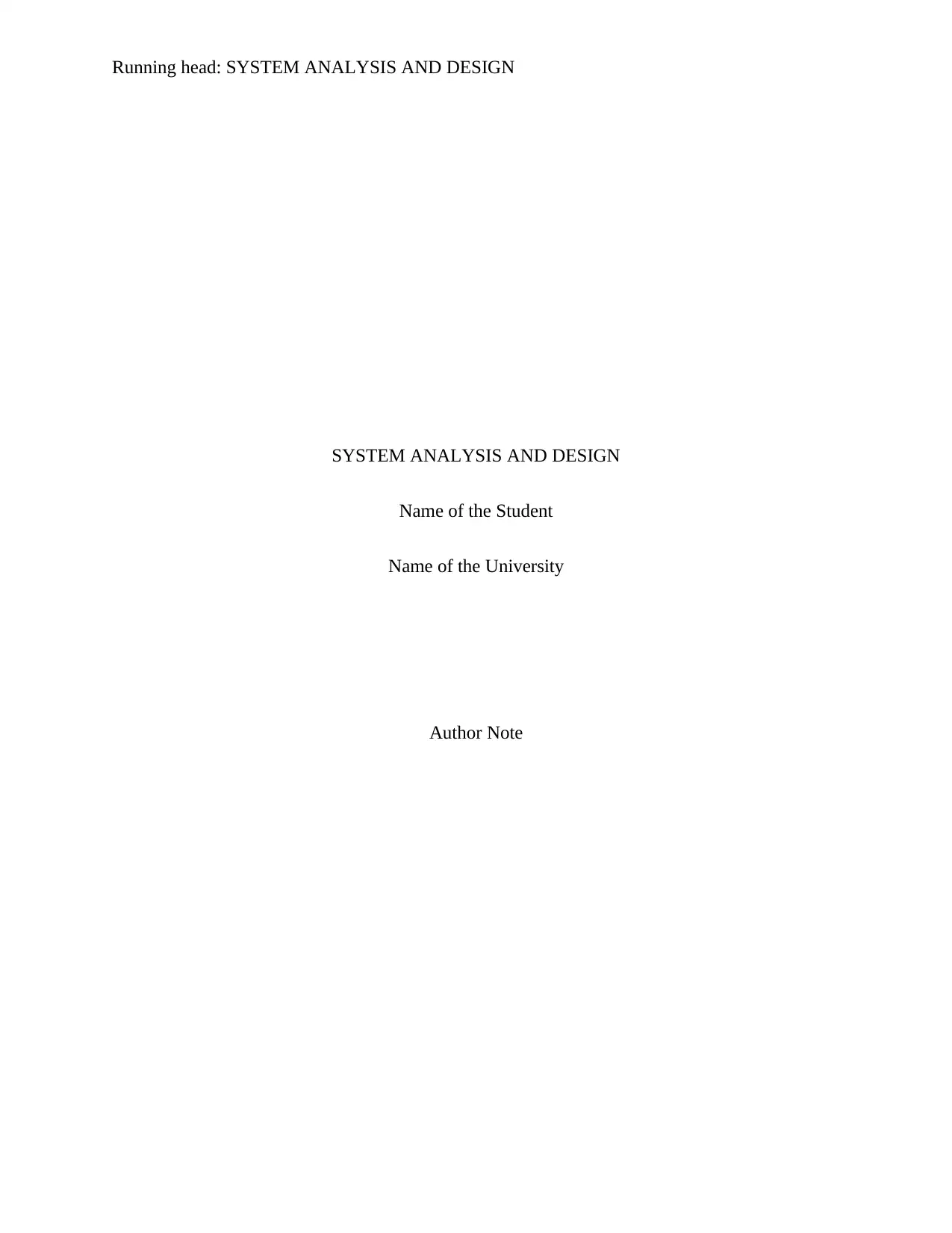
Running head: SYSTEM ANALYSIS AND DESIGN
SYSTEM ANALYSIS AND DESIGN
Name of the Student
Name of the University
Author Note
SYSTEM ANALYSIS AND DESIGN
Name of the Student
Name of the University
Author Note
Paraphrase This Document
Need a fresh take? Get an instant paraphrase of this document with our AI Paraphraser
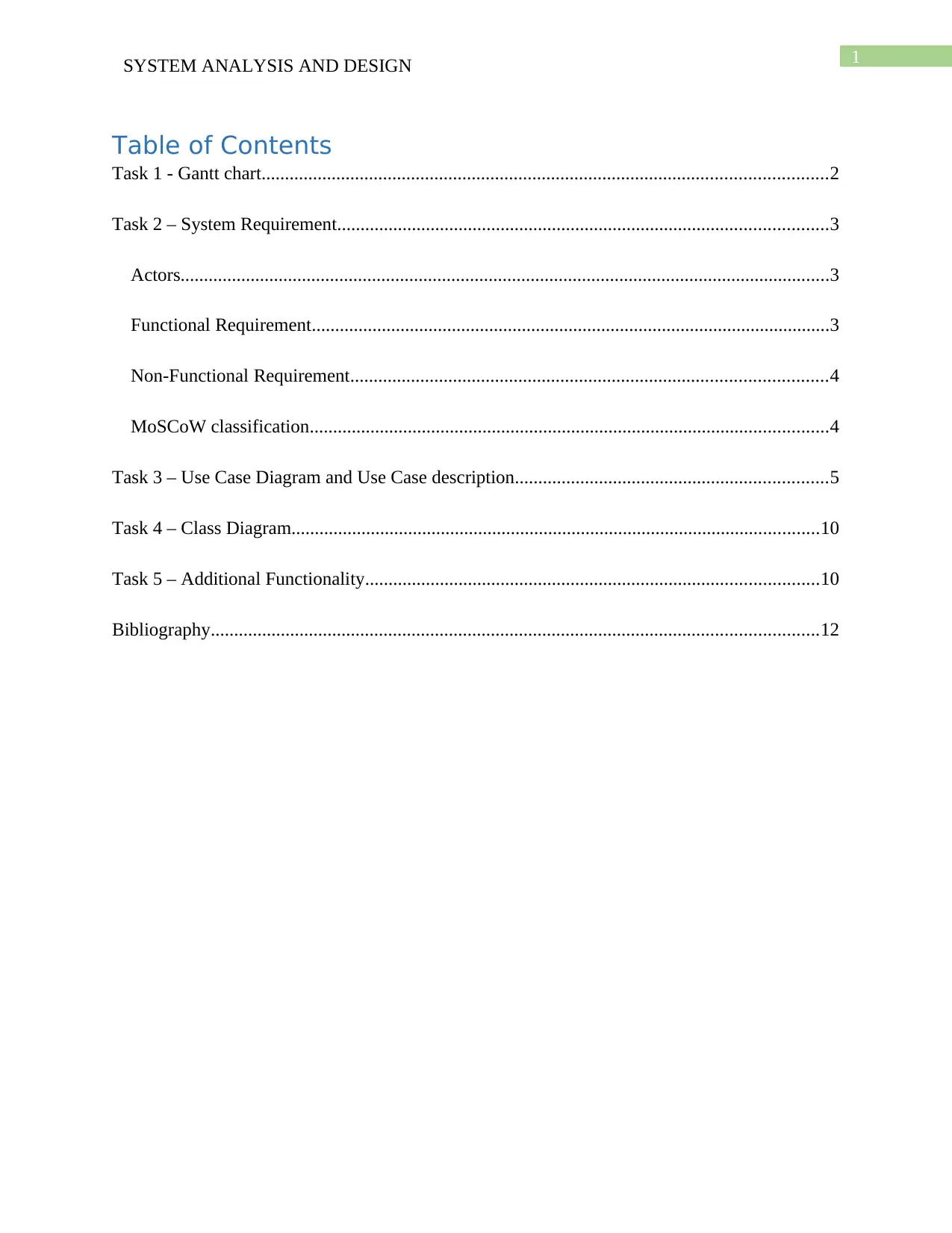
1
SYSTEM ANALYSIS AND DESIGN
Table of Contents
Task 1 - Gantt chart.........................................................................................................................2
Task 2 – System Requirement.........................................................................................................3
Actors...........................................................................................................................................3
Functional Requirement...............................................................................................................3
Non-Functional Requirement......................................................................................................4
MoSCoW classification...............................................................................................................4
Task 3 – Use Case Diagram and Use Case description...................................................................5
Task 4 – Class Diagram.................................................................................................................10
Task 5 – Additional Functionality.................................................................................................10
Bibliography..................................................................................................................................12
SYSTEM ANALYSIS AND DESIGN
Table of Contents
Task 1 - Gantt chart.........................................................................................................................2
Task 2 – System Requirement.........................................................................................................3
Actors...........................................................................................................................................3
Functional Requirement...............................................................................................................3
Non-Functional Requirement......................................................................................................4
MoSCoW classification...............................................................................................................4
Task 3 – Use Case Diagram and Use Case description...................................................................5
Task 4 – Class Diagram.................................................................................................................10
Task 5 – Additional Functionality.................................................................................................10
Bibliography..................................................................................................................................12

2
SYSTEM ANALYSIS AND DESIGN
Task 1 - Gantt chart
ID Task
Mode
Task Name Duration Start Finish
1 Systems Analysis & Design Portfolio5.5 days Mon 3/23/20Mon 3/30/20
2 Systm Requirement Analysis 1.25 days Mon 3/23/20Tue 3/24/20
3 Identification of Actors 3 hrs Mon 3/23/20Mon 3/23/20
4 Requirement Gathering 4 hrs Mon 3/23/20Mon 3/23/20
5 Prioritizing Requirements 3 hrs Mon 3/23/20Tue 3/24/20
6 Milestone 0 0 days Tue 3/24/20Tue 3/24/20
7 Use Case Modelling 1.63 days Tue 3/24/20Wed 3/25/20
8 identification of Use Cases 5 hrs Tue 3/24/20Tue 3/24/20
9 Development of Use case Diagram4 hrs Tue 3/24/20Wed 3/25/20
10 Use Case descriptions 4 hrs Wed 3/25/20Wed 3/25/20
11 Milestone 1 0 days Wed 3/25/20Wed 3/25/20
12 Class Diagram 1.13 days Wed 3/25/20Thu 3/26/20
13 Identification of class,
attributes and methods
4 hrs Wed
3/25/20
Thu
3/26/20
14 Defining Relationship
between classes
5 hrs Thu
3/26/20
Thu
3/26/20
15 Milestone 2 0 days Thu 3/26/20Thu 3/26/20
16 Additional Functionality Analysis1.5 days Fri 3/27/20Mon 3/30/20
17 Identification of additional
features
5 hrs Fri 3/27/20Fri 3/27/20
18 Explanation of actor
associated with new
features
4 hrs Fri 3/27/20Mon
3/30/20
3/24
3/25
3/26
S M T W T F S S M T W T F S S M T W T F S S M T W T F S S
Mar 15, '20 Mar 22, '20 Mar 29, '20 Apr 5, '20 Apr 12, '20
Figure 1: Gantt chart
Source: created by author
Task 2 – System Requirement
System requirement gathering is a vital phase of the system development. It helps in
further designing the system structure and architecture (Coronel and Morris 2016). The
Identification of actors, functional and non-functional requirements are given below.
SYSTEM ANALYSIS AND DESIGN
Task 1 - Gantt chart
ID Task
Mode
Task Name Duration Start Finish
1 Systems Analysis & Design Portfolio5.5 days Mon 3/23/20Mon 3/30/20
2 Systm Requirement Analysis 1.25 days Mon 3/23/20Tue 3/24/20
3 Identification of Actors 3 hrs Mon 3/23/20Mon 3/23/20
4 Requirement Gathering 4 hrs Mon 3/23/20Mon 3/23/20
5 Prioritizing Requirements 3 hrs Mon 3/23/20Tue 3/24/20
6 Milestone 0 0 days Tue 3/24/20Tue 3/24/20
7 Use Case Modelling 1.63 days Tue 3/24/20Wed 3/25/20
8 identification of Use Cases 5 hrs Tue 3/24/20Tue 3/24/20
9 Development of Use case Diagram4 hrs Tue 3/24/20Wed 3/25/20
10 Use Case descriptions 4 hrs Wed 3/25/20Wed 3/25/20
11 Milestone 1 0 days Wed 3/25/20Wed 3/25/20
12 Class Diagram 1.13 days Wed 3/25/20Thu 3/26/20
13 Identification of class,
attributes and methods
4 hrs Wed
3/25/20
Thu
3/26/20
14 Defining Relationship
between classes
5 hrs Thu
3/26/20
Thu
3/26/20
15 Milestone 2 0 days Thu 3/26/20Thu 3/26/20
16 Additional Functionality Analysis1.5 days Fri 3/27/20Mon 3/30/20
17 Identification of additional
features
5 hrs Fri 3/27/20Fri 3/27/20
18 Explanation of actor
associated with new
features
4 hrs Fri 3/27/20Mon
3/30/20
3/24
3/25
3/26
S M T W T F S S M T W T F S S M T W T F S S M T W T F S S
Mar 15, '20 Mar 22, '20 Mar 29, '20 Apr 5, '20 Apr 12, '20
Figure 1: Gantt chart
Source: created by author
Task 2 – System Requirement
System requirement gathering is a vital phase of the system development. It helps in
further designing the system structure and architecture (Coronel and Morris 2016). The
Identification of actors, functional and non-functional requirements are given below.
⊘ This is a preview!⊘
Do you want full access?
Subscribe today to unlock all pages.

Trusted by 1+ million students worldwide
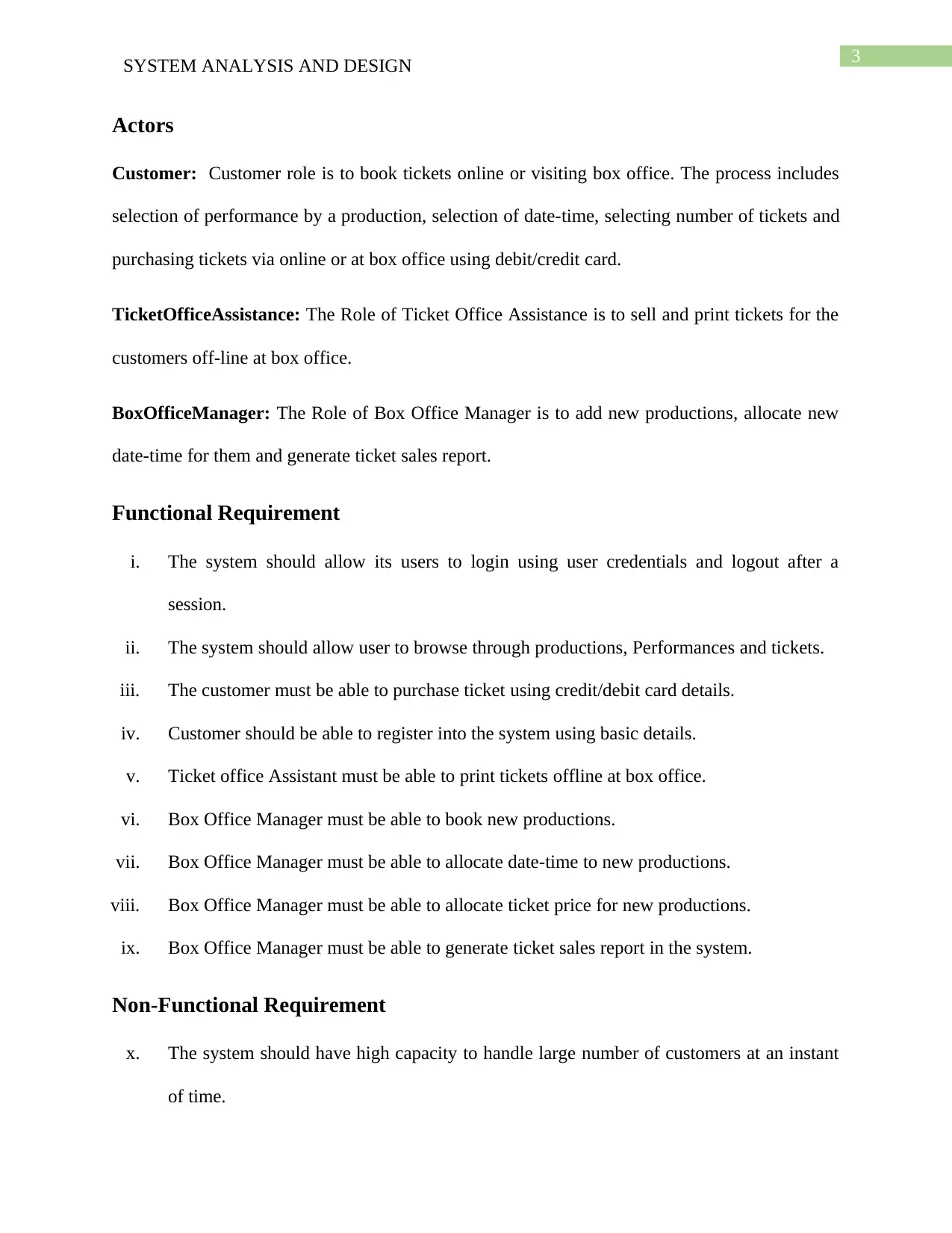
3
SYSTEM ANALYSIS AND DESIGN
Actors
Customer: Customer role is to book tickets online or visiting box office. The process includes
selection of performance by a production, selection of date-time, selecting number of tickets and
purchasing tickets via online or at box office using debit/credit card.
TicketOfficeAssistance: The Role of Ticket Office Assistance is to sell and print tickets for the
customers off-line at box office.
BoxOfficeManager: The Role of Box Office Manager is to add new productions, allocate new
date-time for them and generate ticket sales report.
Functional Requirement
i. The system should allow its users to login using user credentials and logout after a
session.
ii. The system should allow user to browse through productions, Performances and tickets.
iii. The customer must be able to purchase ticket using credit/debit card details.
iv. Customer should be able to register into the system using basic details.
v. Ticket office Assistant must be able to print tickets offline at box office.
vi. Box Office Manager must be able to book new productions.
vii. Box Office Manager must be able to allocate date-time to new productions.
viii. Box Office Manager must be able to allocate ticket price for new productions.
ix. Box Office Manager must be able to generate ticket sales report in the system.
Non-Functional Requirement
x. The system should have high capacity to handle large number of customers at an instant
of time.
SYSTEM ANALYSIS AND DESIGN
Actors
Customer: Customer role is to book tickets online or visiting box office. The process includes
selection of performance by a production, selection of date-time, selecting number of tickets and
purchasing tickets via online or at box office using debit/credit card.
TicketOfficeAssistance: The Role of Ticket Office Assistance is to sell and print tickets for the
customers off-line at box office.
BoxOfficeManager: The Role of Box Office Manager is to add new productions, allocate new
date-time for them and generate ticket sales report.
Functional Requirement
i. The system should allow its users to login using user credentials and logout after a
session.
ii. The system should allow user to browse through productions, Performances and tickets.
iii. The customer must be able to purchase ticket using credit/debit card details.
iv. Customer should be able to register into the system using basic details.
v. Ticket office Assistant must be able to print tickets offline at box office.
vi. Box Office Manager must be able to book new productions.
vii. Box Office Manager must be able to allocate date-time to new productions.
viii. Box Office Manager must be able to allocate ticket price for new productions.
ix. Box Office Manager must be able to generate ticket sales report in the system.
Non-Functional Requirement
x. The system should have high capacity to handle large number of customers at an instant
of time.
Paraphrase This Document
Need a fresh take? Get an instant paraphrase of this document with our AI Paraphraser
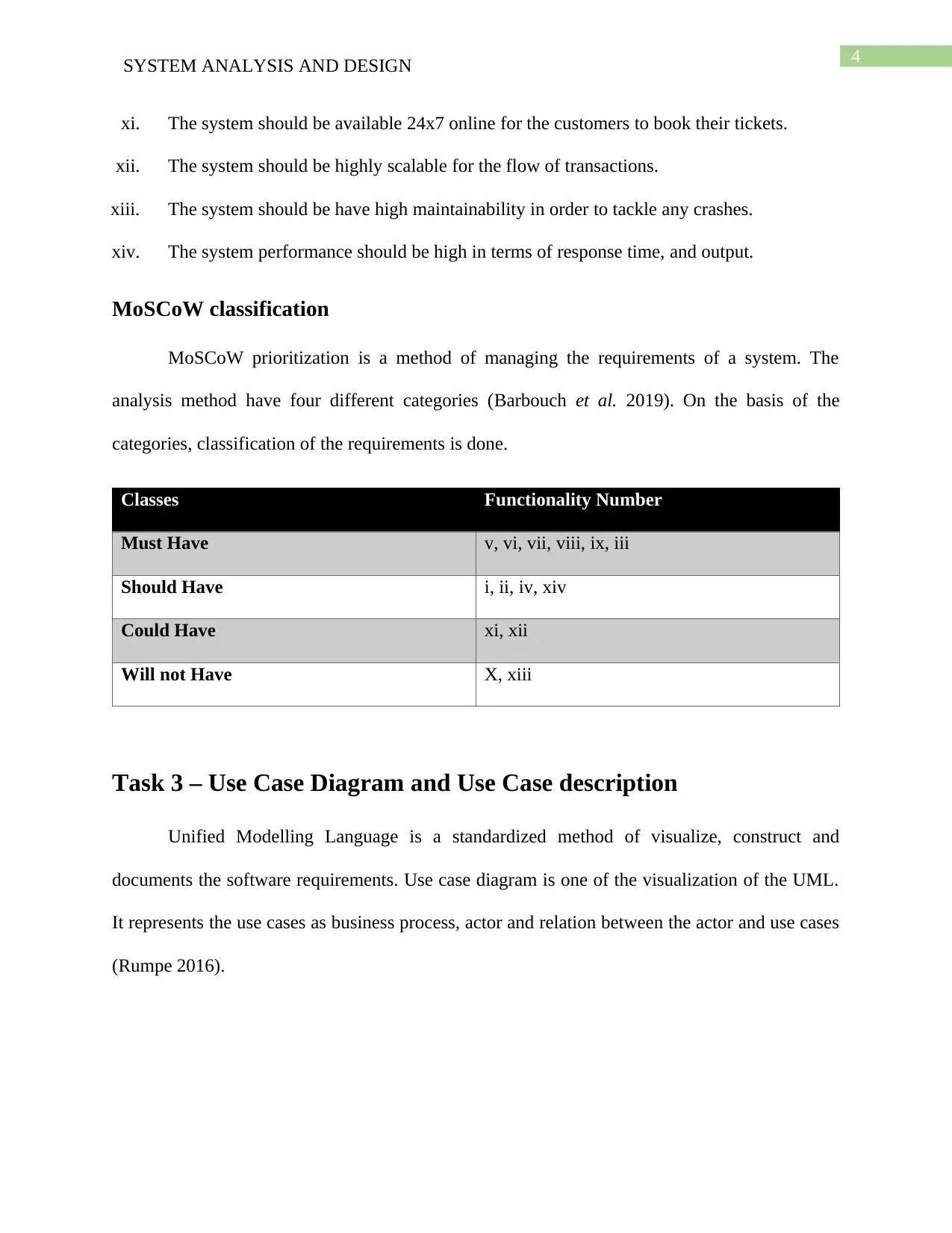
4
SYSTEM ANALYSIS AND DESIGN
xi. The system should be available 24x7 online for the customers to book their tickets.
xii. The system should be highly scalable for the flow of transactions.
xiii. The system should be have high maintainability in order to tackle any crashes.
xiv. The system performance should be high in terms of response time, and output.
MoSCoW classification
MoSCoW prioritization is a method of managing the requirements of a system. The
analysis method have four different categories (Barbouch et al. 2019). On the basis of the
categories, classification of the requirements is done.
Classes Functionality Number
Must Have v, vi, vii, viii, ix, iii
Should Have i, ii, iv, xiv
Could Have xi, xii
Will not Have X, xiii
Task 3 – Use Case Diagram and Use Case description
Unified Modelling Language is a standardized method of visualize, construct and
documents the software requirements. Use case diagram is one of the visualization of the UML.
It represents the use cases as business process, actor and relation between the actor and use cases
(Rumpe 2016).
SYSTEM ANALYSIS AND DESIGN
xi. The system should be available 24x7 online for the customers to book their tickets.
xii. The system should be highly scalable for the flow of transactions.
xiii. The system should be have high maintainability in order to tackle any crashes.
xiv. The system performance should be high in terms of response time, and output.
MoSCoW classification
MoSCoW prioritization is a method of managing the requirements of a system. The
analysis method have four different categories (Barbouch et al. 2019). On the basis of the
categories, classification of the requirements is done.
Classes Functionality Number
Must Have v, vi, vii, viii, ix, iii
Should Have i, ii, iv, xiv
Could Have xi, xii
Will not Have X, xiii
Task 3 – Use Case Diagram and Use Case description
Unified Modelling Language is a standardized method of visualize, construct and
documents the software requirements. Use case diagram is one of the visualization of the UML.
It represents the use cases as business process, actor and relation between the actor and use cases
(Rumpe 2016).
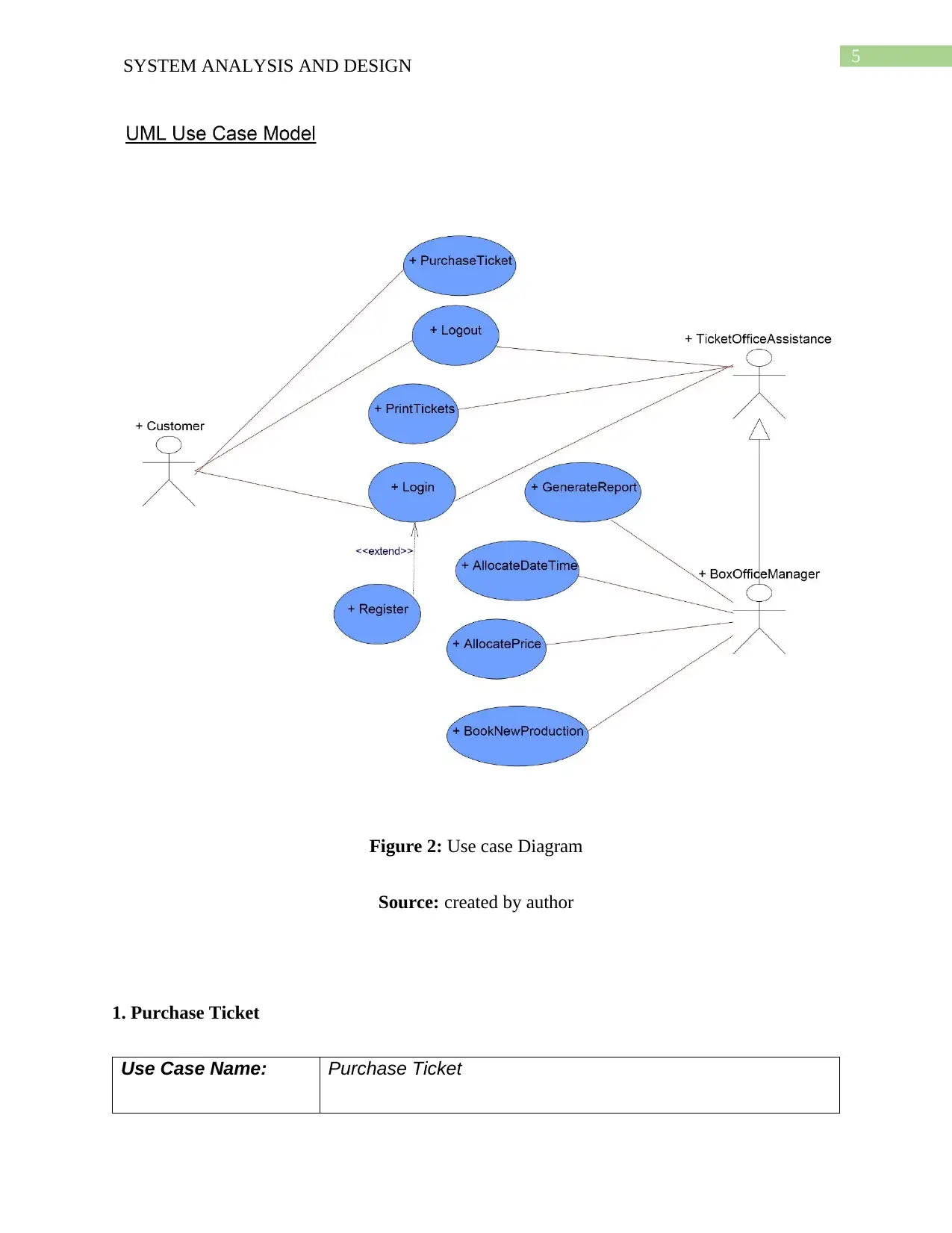
5
SYSTEM ANALYSIS AND DESIGN
Figure 2: Use case Diagram
Source: created by author
1. Purchase Ticket
Use Case Name: Purchase Ticket
SYSTEM ANALYSIS AND DESIGN
Figure 2: Use case Diagram
Source: created by author
1. Purchase Ticket
Use Case Name: Purchase Ticket
⊘ This is a preview!⊘
Do you want full access?
Subscribe today to unlock all pages.

Trusted by 1+ million students worldwide
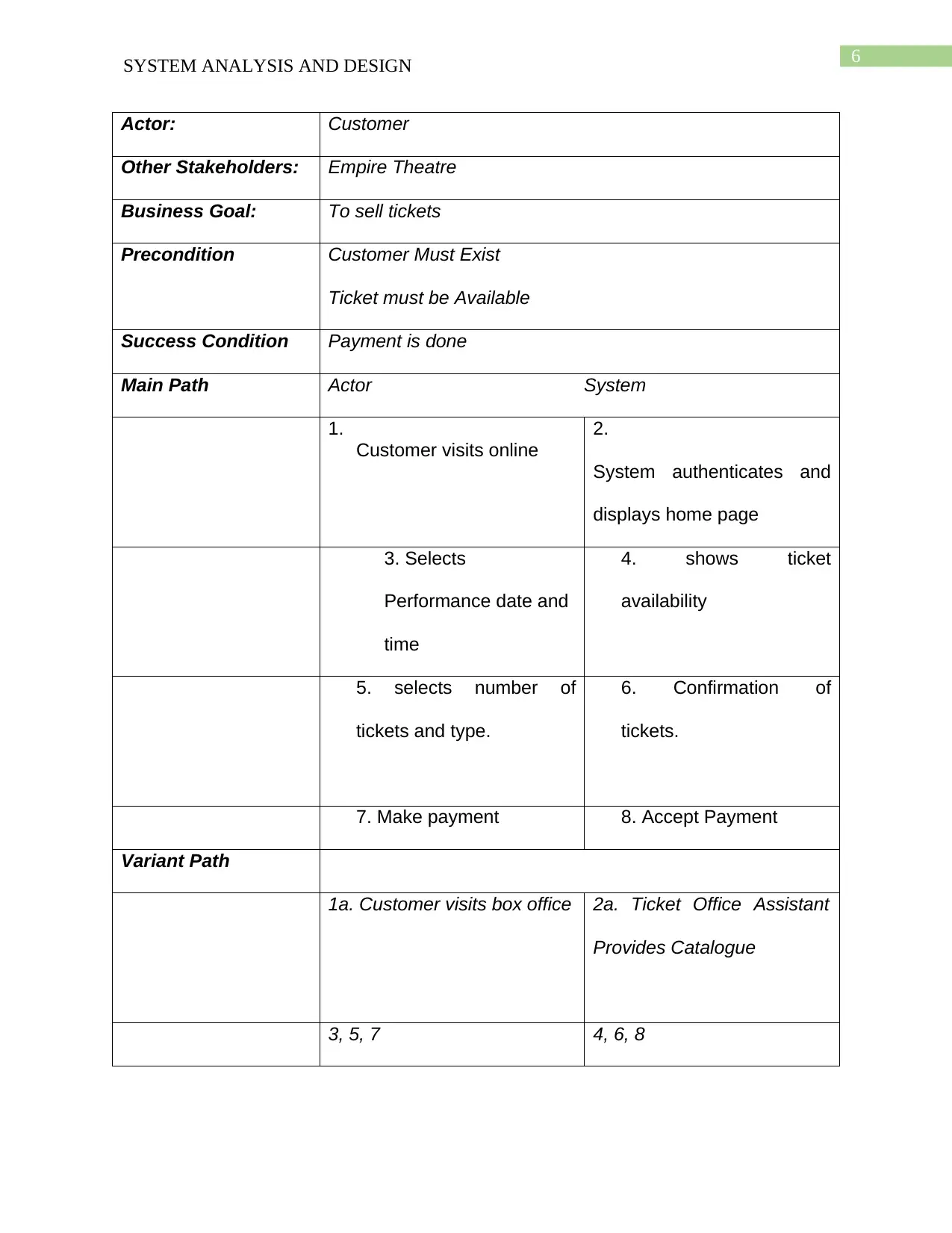
6
SYSTEM ANALYSIS AND DESIGN
Actor: Customer
Other Stakeholders: Empire Theatre
Business Goal: To sell tickets
Precondition Customer Must Exist
Ticket must be Available
Success Condition Payment is done
Main Path Actor System
1.
Customer visits online
2.
System authenticates and
displays home page
3. Selects
Performance date and
time
4. shows ticket
availability
5. selects number of
tickets and type.
6. Confirmation of
tickets.
7. Make payment 8. Accept Payment
Variant Path
1a. Customer visits box office 2a. Ticket Office Assistant
Provides Catalogue
3, 5, 7 4, 6, 8
SYSTEM ANALYSIS AND DESIGN
Actor: Customer
Other Stakeholders: Empire Theatre
Business Goal: To sell tickets
Precondition Customer Must Exist
Ticket must be Available
Success Condition Payment is done
Main Path Actor System
1.
Customer visits online
2.
System authenticates and
displays home page
3. Selects
Performance date and
time
4. shows ticket
availability
5. selects number of
tickets and type.
6. Confirmation of
tickets.
7. Make payment 8. Accept Payment
Variant Path
1a. Customer visits box office 2a. Ticket Office Assistant
Provides Catalogue
3, 5, 7 4, 6, 8
Paraphrase This Document
Need a fresh take? Get an instant paraphrase of this document with our AI Paraphraser
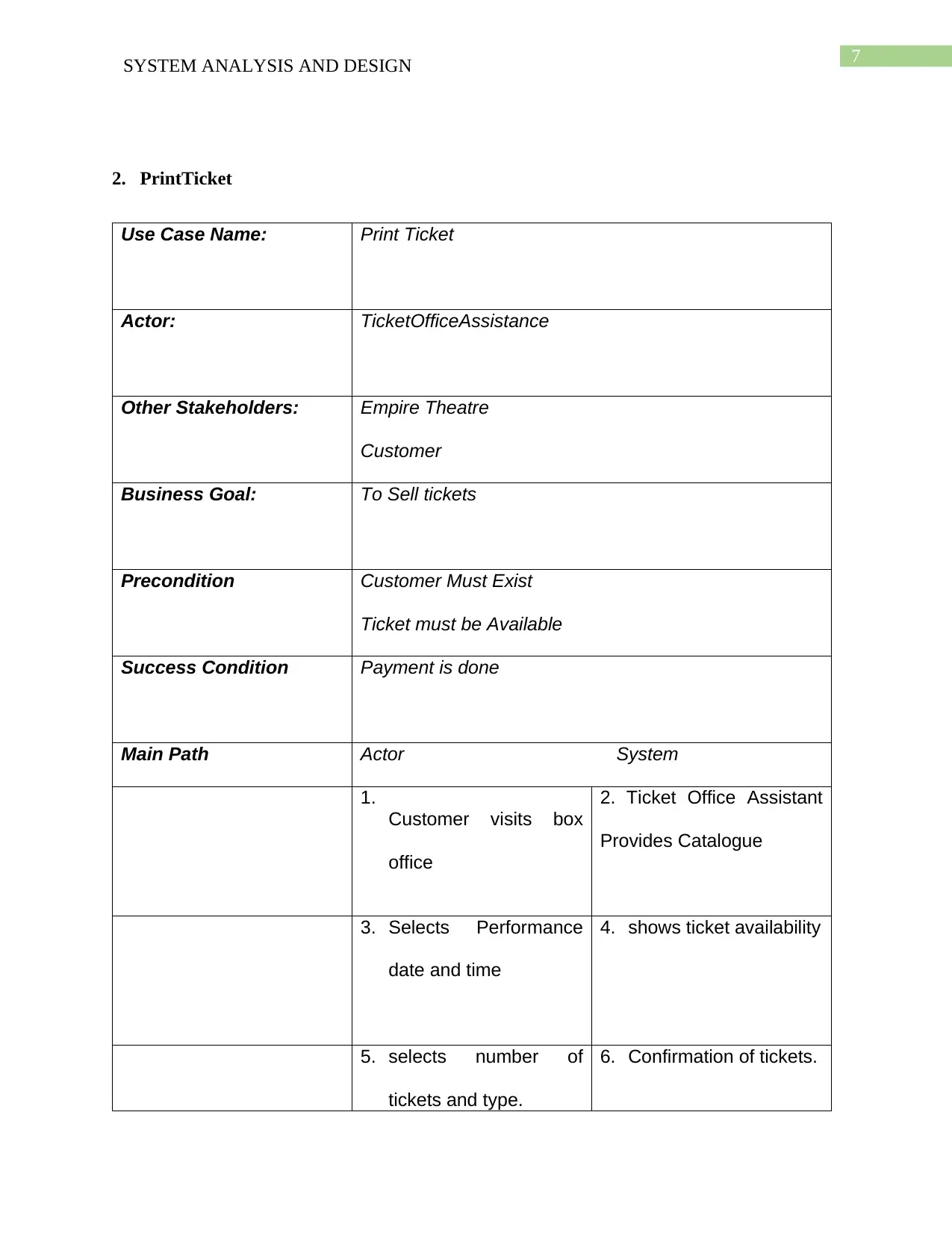
7
SYSTEM ANALYSIS AND DESIGN
2. PrintTicket
Use Case Name: Print Ticket
Actor: TicketOfficeAssistance
Other Stakeholders: Empire Theatre
Customer
Business Goal: To Sell tickets
Precondition Customer Must Exist
Ticket must be Available
Success Condition Payment is done
Main Path Actor System
1.
Customer visits box
office
2. Ticket Office Assistant
Provides Catalogue
3. Selects Performance
date and time
4. shows ticket availability
5. selects number of
tickets and type.
6. Confirmation of tickets.
SYSTEM ANALYSIS AND DESIGN
2. PrintTicket
Use Case Name: Print Ticket
Actor: TicketOfficeAssistance
Other Stakeholders: Empire Theatre
Customer
Business Goal: To Sell tickets
Precondition Customer Must Exist
Ticket must be Available
Success Condition Payment is done
Main Path Actor System
1.
Customer visits box
office
2. Ticket Office Assistant
Provides Catalogue
3. Selects Performance
date and time
4. shows ticket availability
5. selects number of
tickets and type.
6. Confirmation of tickets.
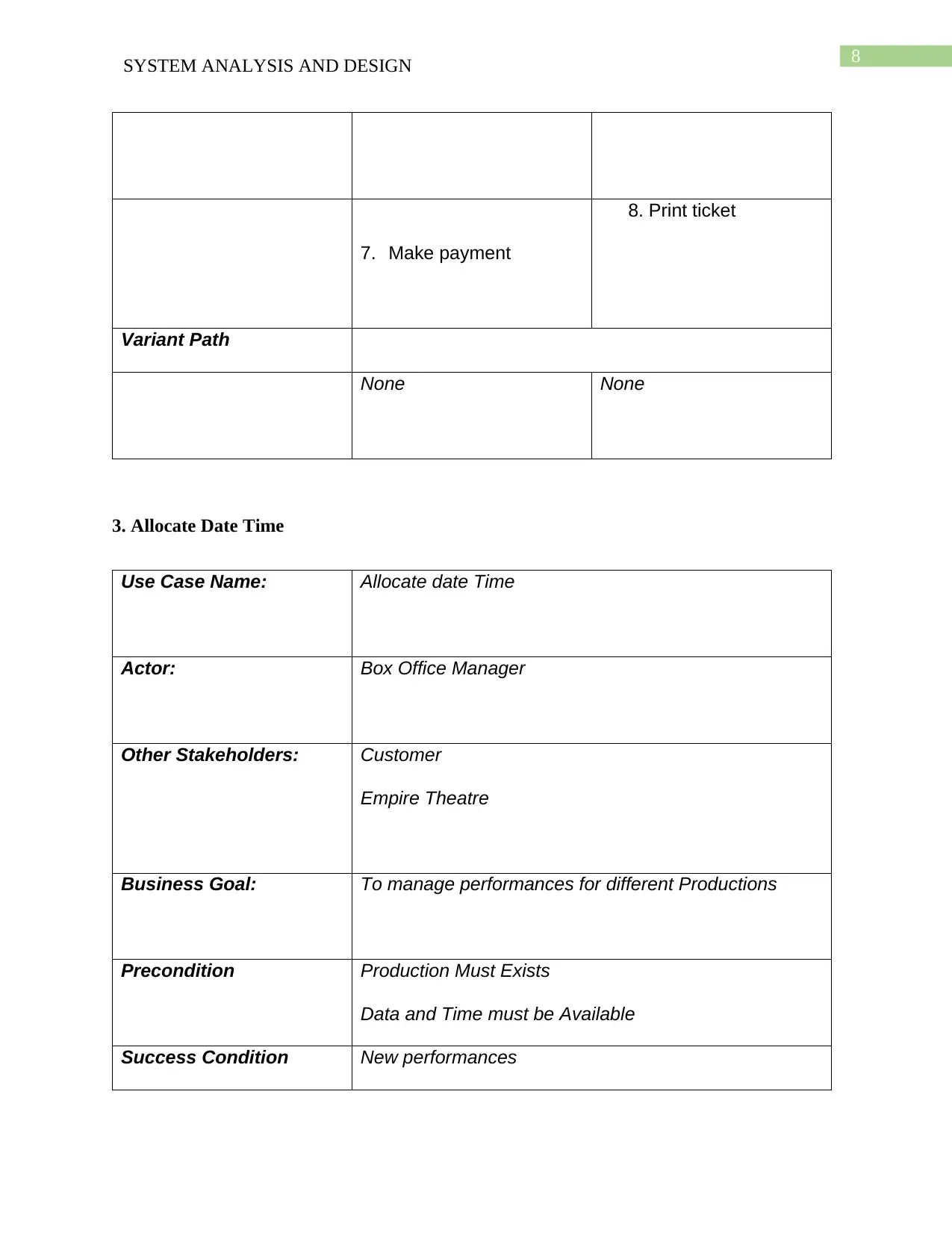
8
SYSTEM ANALYSIS AND DESIGN
7. Make payment
8. Print ticket
Variant Path
None None
3. Allocate Date Time
Use Case Name: Allocate date Time
Actor: Box Office Manager
Other Stakeholders: Customer
Empire Theatre
Business Goal: To manage performances for different Productions
Precondition Production Must Exists
Data and Time must be Available
Success Condition New performances
SYSTEM ANALYSIS AND DESIGN
7. Make payment
8. Print ticket
Variant Path
None None
3. Allocate Date Time
Use Case Name: Allocate date Time
Actor: Box Office Manager
Other Stakeholders: Customer
Empire Theatre
Business Goal: To manage performances for different Productions
Precondition Production Must Exists
Data and Time must be Available
Success Condition New performances
⊘ This is a preview!⊘
Do you want full access?
Subscribe today to unlock all pages.

Trusted by 1+ million students worldwide
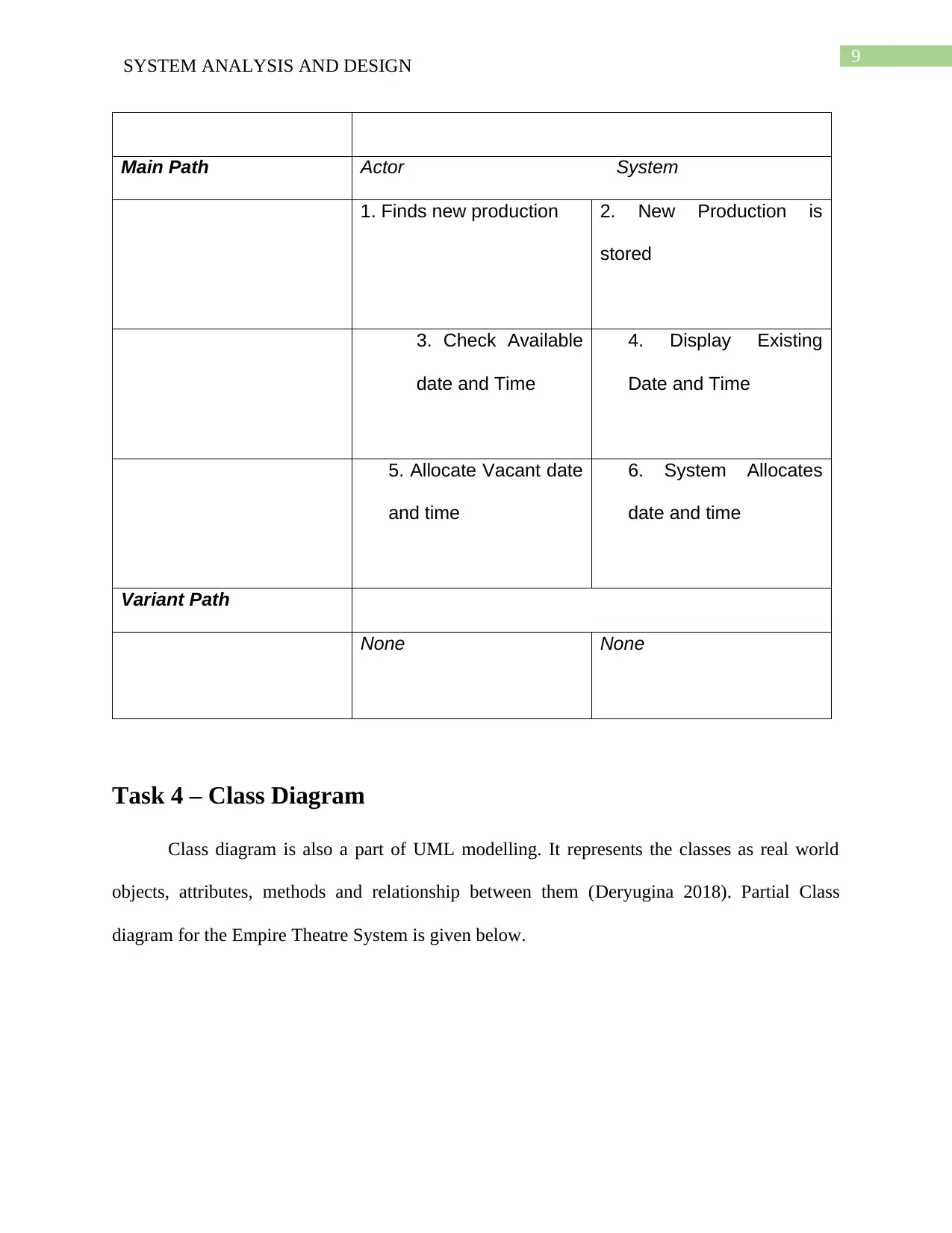
9
SYSTEM ANALYSIS AND DESIGN
Main Path Actor System
1. Finds new production 2. New Production is
stored
3. Check Available
date and Time
4. Display Existing
Date and Time
5. Allocate Vacant date
and time
6. System Allocates
date and time
Variant Path
None None
Task 4 – Class Diagram
Class diagram is also a part of UML modelling. It represents the classes as real world
objects, attributes, methods and relationship between them (Deryugina 2018). Partial Class
diagram for the Empire Theatre System is given below.
SYSTEM ANALYSIS AND DESIGN
Main Path Actor System
1. Finds new production 2. New Production is
stored
3. Check Available
date and Time
4. Display Existing
Date and Time
5. Allocate Vacant date
and time
6. System Allocates
date and time
Variant Path
None None
Task 4 – Class Diagram
Class diagram is also a part of UML modelling. It represents the classes as real world
objects, attributes, methods and relationship between them (Deryugina 2018). Partial Class
diagram for the Empire Theatre System is given below.
Paraphrase This Document
Need a fresh take? Get an instant paraphrase of this document with our AI Paraphraser

10
SYSTEM ANALYSIS AND DESIGN
Figure 3: Class Diagram
Source: created by author
Task 5 – Additional Functionality
Cancel and refund: Cancellations of the tickets and refunds of the payment should include in
the system. The refund price can be set in the system on the basis of the duration gap between the
cancellations date and performance date. The Ticket Office Assistance should handle the
cancellation and refund of the tickets for offline. On online the refund should be reflected to the
customer’s account from which it was booked. It will increase the customer satisfaction by
increasing their confidence in the business services.
SYSTEM ANALYSIS AND DESIGN
Figure 3: Class Diagram
Source: created by author
Task 5 – Additional Functionality
Cancel and refund: Cancellations of the tickets and refunds of the payment should include in
the system. The refund price can be set in the system on the basis of the duration gap between the
cancellations date and performance date. The Ticket Office Assistance should handle the
cancellation and refund of the tickets for offline. On online the refund should be reflected to the
customer’s account from which it was booked. It will increase the customer satisfaction by
increasing their confidence in the business services.
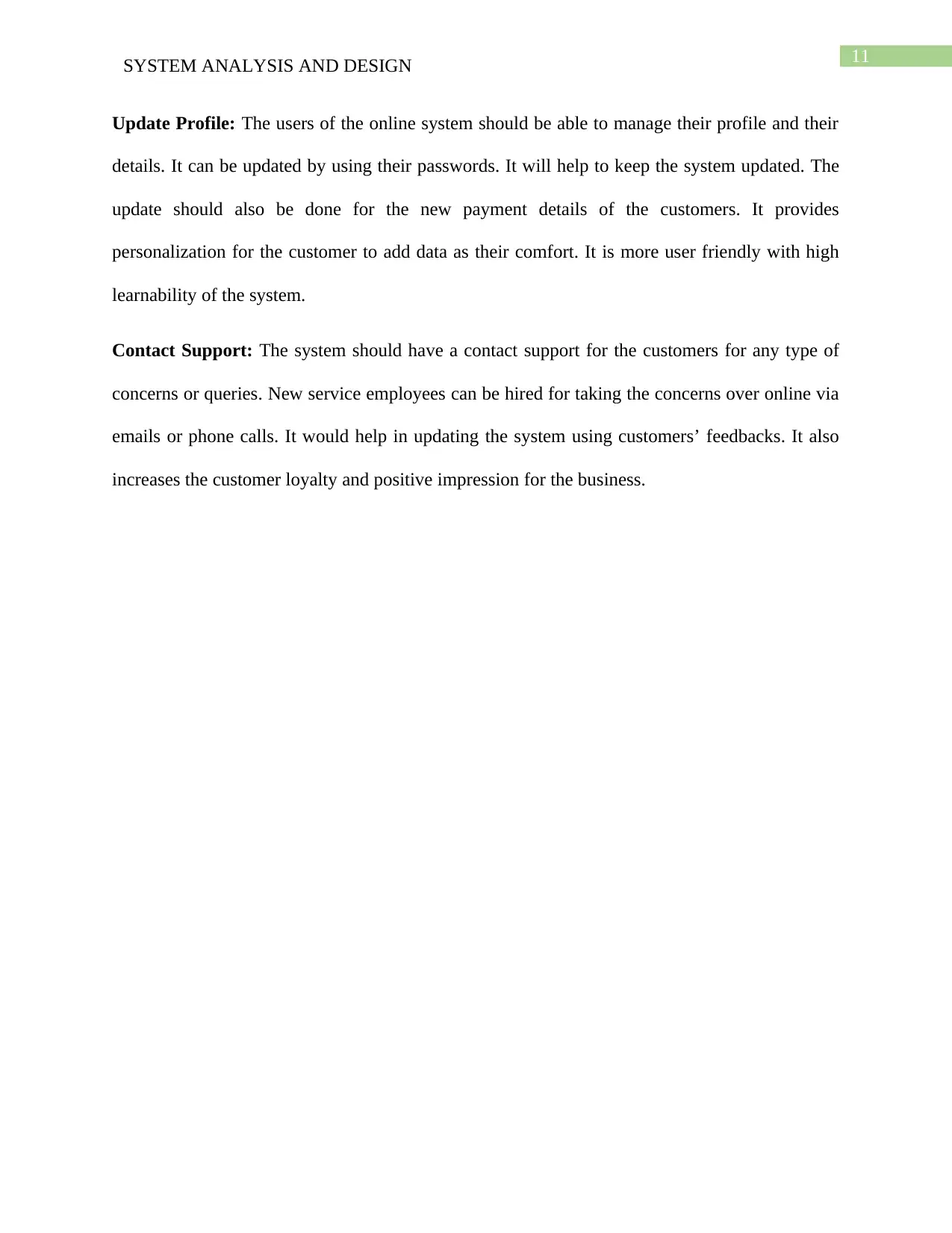
11
SYSTEM ANALYSIS AND DESIGN
Update Profile: The users of the online system should be able to manage their profile and their
details. It can be updated by using their passwords. It will help to keep the system updated. The
update should also be done for the new payment details of the customers. It provides
personalization for the customer to add data as their comfort. It is more user friendly with high
learnability of the system.
Contact Support: The system should have a contact support for the customers for any type of
concerns or queries. New service employees can be hired for taking the concerns over online via
emails or phone calls. It would help in updating the system using customers’ feedbacks. It also
increases the customer loyalty and positive impression for the business.
SYSTEM ANALYSIS AND DESIGN
Update Profile: The users of the online system should be able to manage their profile and their
details. It can be updated by using their passwords. It will help to keep the system updated. The
update should also be done for the new payment details of the customers. It provides
personalization for the customer to add data as their comfort. It is more user friendly with high
learnability of the system.
Contact Support: The system should have a contact support for the customers for any type of
concerns or queries. New service employees can be hired for taking the concerns over online via
emails or phone calls. It would help in updating the system using customers’ feedbacks. It also
increases the customer loyalty and positive impression for the business.
⊘ This is a preview!⊘
Do you want full access?
Subscribe today to unlock all pages.

Trusted by 1+ million students worldwide
1 out of 13
Related Documents
Your All-in-One AI-Powered Toolkit for Academic Success.
+13062052269
info@desklib.com
Available 24*7 on WhatsApp / Email
![[object Object]](/_next/static/media/star-bottom.7253800d.svg)
Unlock your academic potential
Copyright © 2020–2025 A2Z Services. All Rights Reserved. Developed and managed by ZUCOL.





